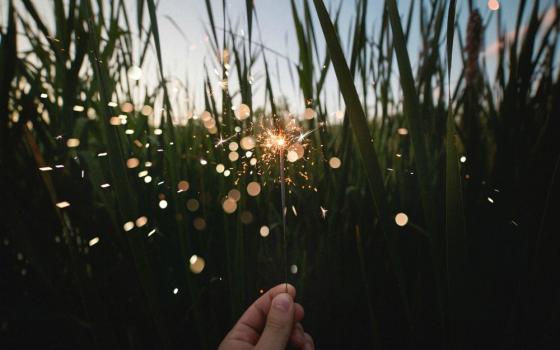Besides a trailer for the Netflix series "Tidying Up with Marie Kondo," I haven't seen much of its content, yet the question central to Kondo's philosophy of decluttering has somehow made its way into my life. The past few weeks, as Lent has come to a close and Easter quickly approaches, a question has kept surfacing in real and surreal ways in my life: What sparks joy?
I happened upon the question quite by accident. At first, people would dramatically hold up objects in the midst of everyday situations and jokingly ask me, "Does this spark joy?" Then news articles began to surface in my social media feeds, followed by think pieces about why people were so captivated by Marie Kondo, a Japanese organizing consultant, author and, now, television personality. Soon, I began to look around me and echo the question central to her philosophy; somehow, even though I hadn't watched the show, it was having an influence on me.
As that question — Does it spark joy? — surfaced time and again, I began to look at what objects line my walls. Glancing around the spaces of my life — my bedroom, my office, my community — I recognized the glimmers of joy surrounding me. I saw the many markers of where I've been: objects that signify moments on my journey, totems of people and places that hold significance in my life, and souvenirs of lessons and ideals that have become part of the very marrow of my being.
There were crosses from my travels and homemade prints, family photos and gifts from friends. Joy is only part of why I keep these things around. I keep these items because they are place holders. They are reminders of the gifts of being alive, the lessons of experience, and the palpable presence of the sacred in very specific moments of my life.
We hold onto objects like this because in a way they hold sacred space for us. We need them because, beyond joy, they spark a remembrance in us of what is most holy and significant. There is no need to tidy up these moments. We hold them and they hold us and in moments when light seems dim, they spark something deep within, reminding us what the light is that we've experienced and we are meant to bear.
By acknowledging that significance, we can identify that light (and bear it to the world). And when we do that, we don't need any objects. Instead, we become the sacred spaces — living, moving, and breathing — that once captivated us.
The sacred spaces of our lives, after all, are spaces that have always just been waiting for us to enter. It is not our presence that sanctifies them. Each moment is holy. Our recognition of the Sacred in our midst, though, opens up a space to receive the sacred deep within us. This openness makes us a vessel, a means of carrying the holy far beyond a singular moment. If we are aware enough, that is to say attentive enough to grace, we can engrain the sacred moments and spaces of our lives into our very beings, revealing them in who we are and how we are in the world, becoming purveyors of sacred space in our everyday lives, peddling God's grace in the many spaces we are blessed to inhabit.
As L. William Countryman writes in his book Living on the Border of the Holy:
It can be helpful to imagine our human encounter with the Holy as life in a border country. It is a country in which, at privileged moments of access, we find ourselves looking over from the everyday world into another, into a world that undergirds the everyday world, limits it, defines it, gives it coherence and meaning, drives it. Yet this hidden world is not another world, but the familiar world discovered afresh.
The world we live in is filled with holiness. The discovery of the sacred in the mundane fills us with amazement, and as Countryman continues, "In the long run we find that the border country is in fact the place we have always lived, but it is seen in a new and clearer light."
Our call is to dare to cross that border and establish connection not only for our life, but for the life of the world. More often than not, this requires our branching out beyond our own boundaries, our sharing of the sacred by revealing the stories of the objects we carry with us and also being willing to hear the stories others have to offer.
Dietrich Bonhoeffer speaks directly to this point. "The first service one owes to others in a community involves listening to them," he declares. "Just as our love for God begins with listening to God's Word, the beginning of love for others is learning to listen to them. God's love for us is shown by the fact that God not only gives God's Word but also lends us God's ear."
With God's ears we learn to listen in a new way; we develop a manner of listening to and from the heart. The to and fro of this listening is a bridge that connects us, a pathway for the Sacred to make connection and to take up residence in yet another personified place. I can only imagine the joy such connection sparks in the heart of God.
With such joy comes the invitation to not just hold on to what has been but to once again encounter the Holy in the here and now. Holding firm to such experiences and the receptivity they nurture in us, we are able to both hold sacred space for others and be held in the sacred space God calls us to dwell in.
As Lent comes to a close and Easter approaches, we bear witness to the hopeful work of this season, work of renewing and refining our lives enough to better hold the Holy. We can tidy all we want but we must also realize that sacred space is most often found in the midst of mess. Embracing God present to us in all things — life, death, and resurrection — is our true invitation. Accepting that invitation and all the people, places and objects that hold it gives purpose to our being and, beyond the shadow of any doubt, sparks joy deep within, joy that is truly inextinguishable.
[Colleen Gibson is a Sister of St. Joseph of Philadelphia. Author of the blog Wandering in Wonder, she currently serves as coordinator of services at the SSJ Neighborhood Center in Camden, New Jersey.]

